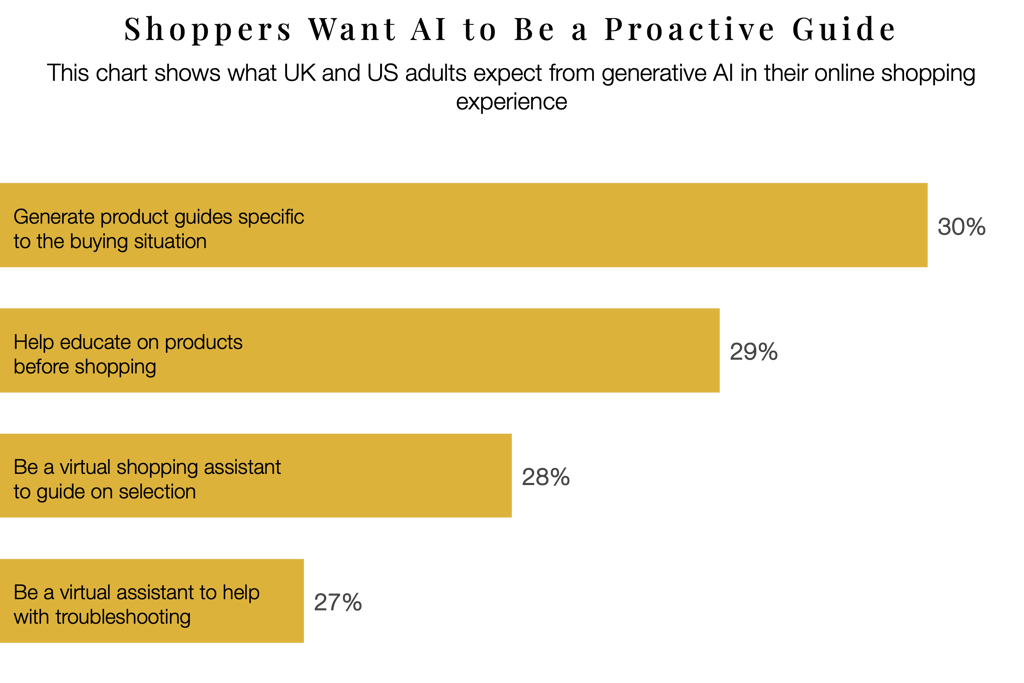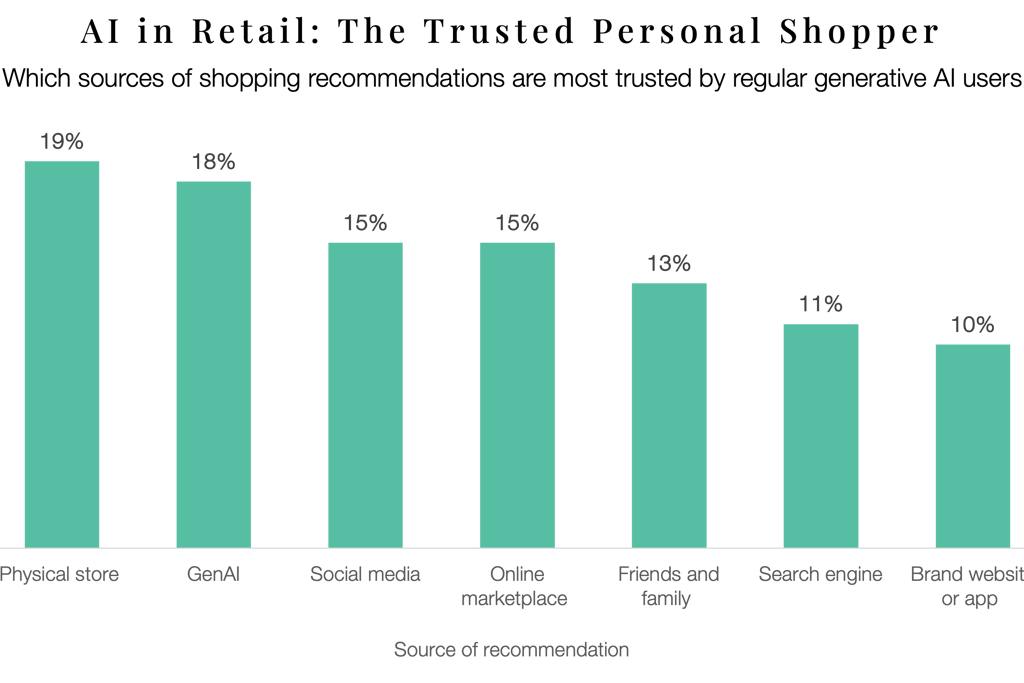AI in Retail: From Chatbots to Trusted Shopping Companions
Learn how the evolution of AI in retail is transforming ecommerce, as generative AI chatbots become trusted shopping companions that enhance the customer experience and drive sales.
AI IN RETAIL AND ECOMMERCE
Garret Farmer-Brent
7/30/2025


The Bottleneck of the Past: Why Traditional Chatbots Failed to Inspire
To appreciate the current revolution, we must first acknowledge the limitations of the past. Traditional chatbots operated on a simple, rule-based logic. They could only respond to a narrow set of predefined queries and keywords.
This led to common customer frustrations:
Repetitive Loops: An inability to understand nuanced language trapped users in frustrating "I don't understand" loops.
Lack of Context: The chatbot had no memory of past interactions, treating every query as a new, isolated event.
Impersonal Experience: Every customer received the same scripted answers, regardless of their purchase history, preferences, or position in the customer journey.
These bots were a tool for cost-cutting, not for enhancing the customer experience. They could handle basic FAQs, but they couldn't sell, persuade, or personalize. The transition to a more intelligent system was not just necessary; it was inevitable.
For years, the promise of AI in retail has been simmering. Business owners have been told that artificial intelligence would revolutionize the customer experience, but the reality often fell short. Early chatbots, tethered to rigid scripts, frequently led to dead ends and frustrated customers, becoming a symbol of automated indifference rather than intelligent assistance.
That era is officially over.
The arrival of powerful, accessible generative AI has triggered a seismic shift in the ecommerce landscape. Powered by the same large language models (LLMs) that fuel tools like ChatGPT, today's AI chatbots are dismantling the old limitations. They are evolving from clunky, reactive support tools into sophisticated, proactive conversational AI companions.
For retail and ecommerce business owners, this isn't just another tech trend; it's a fundamental change in how you can engage, guide, and convert customers. This is the dawn of the AI shopping companion—a tool that doesn't just answer questions but builds relationships.
The New Frontier: What Customers Expect from AI in Retail
Consumers are no longer just tolerant of AI; they are actively looking for it to improve their shopping experience. They don't just want answers; they want guidance. Data from late 2024 shows a clear demand for AI that actively assists in the shopping journey, moving beyond simple troubleshooting.


Source: Coveo, Arlington Research
This data reveals a crucial insight: customers are ready for a conversation. They want an AI that can act as a knowledgeable store associate, guiding them to the perfect product and making the discovery process seamless and even enjoyable.
The AI Shopping Companion: A New Paradigm for Customer Engagement
So, what does this new breed of generative AI chatbot do differently? It leverages natural language processing (NLP) to understand intent, context, and sentiment, allowing it to move fluidly between different roles.
1. The Expert Product Discoverer
A customer no longer needs to know the exact product name or category. They can use natural, descriptive language like, "I'm looking for a durable, waterproof jacket for hiking in the mountains this autumn," and the AI can parse this request to recommend relevant products. As seen with retailers like Nordstrom, AI can even generate trend reports or "Style Swipes" to help users discover products based on their unique habits. This capability is a powerful antidote to "decision paralysis," the feeling of being overwhelmed by too many choices that causes nearly three-quarters of consumers to abandon purchases.
2. The Trusted Personal Shopper
Perhaps the most game-changing development is the level of trust consumers are placing in AI. The technology is rapidly becoming a go-to source for recommendations, in some cases eclipsing even the most traditional sources of advice.


This data is a clear signal to business owners: your AI strategy is no longer just a customer service strategy—it's a core part of your brand's credibility and influence. An AI that provides genuinely helpful, personalized, and explainable recommendations can become a trusted companion, building a level of loyalty that was previously only possible through human interaction.
3. The 24/7 Conversational Guide
Unlike a static webpage, a generative AI chatbot creates a dynamic, two-way dialogue. It can:
Ask clarifying questions to narrow down options.
Compare products side-by-side based on features the customer cares about.
Offer post-purchase support, from tracking deliveries to initiating returns, all within the same conversational thread.
Research shows that where retailers are focusing their AI investment (top-of-funnel acquisition) and what consumers actually want (help with post-purchase friction) are misaligned. A conversational AI chatbot bridges this gap, offering a consistent and intelligent touchpoint across the entire customer journey.
Implementing Your Conversational AI Strategy: Where to Start
Embracing this technology doesn't have to be an overwhelming overhaul. The key is to be strategic and focus on solving real customer problems.
Focus on Friction First: Before dreaming up futuristic shopping experiences, identify the biggest points of friction in your current customer journey. Is it finding the right product? Understanding complex features? Handling returns? Deploy your AI to solve these practical problems first. Consumers are far more interested in an AI that can simplify a return than one that offers a novelty experience.
Build on a Foundation of First-Party Data: The "intelligence" in your AI comes from data. To deliver true personalization, your chatbot needs secure access to customer data—purchase history, browsing behavior, and stated preferences. Strengthening your first-party data capabilities is the single most important step you can take to prepare for an AI-driven future.
Prioritize Trust and Transparency: With 70% of consumers feeling "emotionally manipulated" by AI shopping assistants, building trust is non-negotiable. Be transparent about when a customer is interacting with an AI. Give users control, allowing them to easily opt-out or request a human agent. As one report notes, trust-builders include strong privacy protections and requiring consumer approval before making a purchase.
Source: Accenture Consumer Pulse
The Future is a Conversation
The evolution from clicks to conversations is here. Generative AI chatbots have matured from a simple support function into a strategic asset capable of driving revenue, building brand loyalty, and creating a deeply personalized customer experience.
For retail and ecommerce business owners, the question is no longer if you should adopt a conversational AI strategy, but how quickly you can implement one that is authentic to your brand and genuinely helpful to your customers. The businesses that embrace this new paradigm and build AI-powered shopping companions that are both intelligent and trustworthy will be the ones that thrive in the years to come.
Is your retail business ready for the next upgrade to you technology mix – but you don't know where to start?
Begin your AI business upgrade today by taking our comprehensive AI Readiness Assessment.
You'll receive a full business analysis report at no charge.




